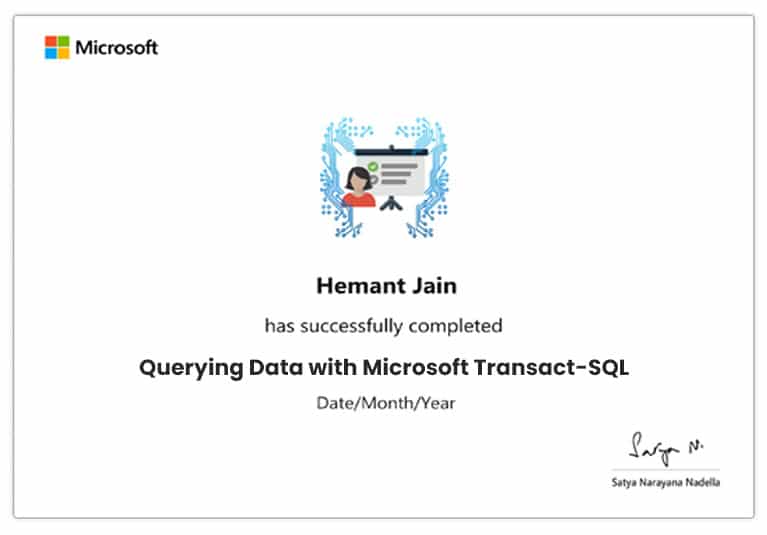Your cart is currently empty.
Our MSBI and SQL certification master's program lets you gain proficiency in Microsoft Business Intelligence. You will work on real-world industry projects pertaining to the three components of MSBI, SSIS for ETL, SSAS for analysis, and SSRS for reporting along with data mining queries, Visual Studio, SQL Server, OLAP, generating Cubes, data sources, and converting raw data into business insights. As part of this online classroom training, you will also receive the official course material issued by Microsoft for Analyzing Data with SQLRead More..

Watch
Course PreviewRead More
Having a basic knowledge of RDBMS is beneficial but not compulsory for taking up this combo course.
MSBI is a powerful Business Intelligence tool that is used by enterprises across the board for quick decision-making, coming up with in-depth reporting, and deriving meaningful insights. This combo training course will provide you the right wherewithal to work on critical projects that need extensive knowledge of SSAS, SSIS, and SSRS. This can open the doors to high-paying jobs in the best companies.
Talk To Us
We are happy to help you 24/7
₹13,281
EMI Starts at
₹5,000
We partnered with financing companies to provide very competitive finance options at 0% interest rate
Financing Partners
![]()
Contact Us
Introduction to Business Intelligence, understanding the concept of Data Modeling, Data Cleaning, learning about Data Analysis, Data Representation, Data Transformation.
Introduction to ETL, the various steps involved Extract, Transform, Load, using a user’s email ID to read a flat file, extracting the User ID from email ID, loading the data into a database table.
Introduction to Connection Managers – logical representation of a connection, the various types of Connection Managers – Flat file, database, understanding how to load faster with OLE DB, comparing the performance of OLE DB and ADO.net, learning about Bulk Insert, working with Excel Connection Managers and identifying the problems.
Learning what is Data Transformation, converting data from one format to another, understanding the concepts of Character Map, Data Column and Copy Column Transformation, import and export column transformation, script and OLEDB Command Transformation, understanding row sampling, aggregate and sort transformation, percentage and row sampling.
Understanding Pivot and UnPivot Transformation, understanding Audit and Row Count Transformation, working with Split and Join Transformation, studying Lookup and Cache Transformation, Integrating with Azure Analysis Services, elastic nature of MSBI to integrate with the Azure cloud service, scale out deployment option for MSBI, working with cloud-borne data sources and query analysis. Scaling out the SSIS package, deploying for tighter windows, working with larger amount of data sources, SQL Server vNext for enhancing SQL Server features, more choice of development languages and data types both on-premise and in the cloud.
Understanding data that slowly changes over time, learning the process of how new data is written over old data, best practices.Detail explanation of three types of SCDs –Type1, Type2 and Type3, and their differences.
Understanding how Fuzzy Lookup Transformation varies from Lookup Transformation, the concept of Fuzzy matching,
Learning about error rows configuration, package logging, defining package configuration, understanding constraints and event handlers.
Get introduced to the SSRS Architecture, components of SSRS Report Building tool, learning about the data flow in different components.
Understanding the concepts of Matrix and Tablix, working with Text Box, learning about formatting, row/column grouping, understanding sorting, formatting, concepts of Header, Footer, Totals, Subtotals and Page Breaks.
Learning about Parameters, filter and visibility expression, understanding drill-through and drill-down, defining variables, custom code.
Introduction to various aspects of Bar Chart, Line Chart, Combination Chart, Shape Chart, Sub Reports, Integration of Power Query and M language with SSRS, working with additional data sources in MSBI, rich transformation capabilities addition to MSBI, reusing M functions build for PBIX in SSRS.
Learn how to build a Dashboard with Sparklines, Data Bars, Map Charts, Gauge Charts and drilling into reports, the basics of ad hoc reporting.
Data Bar, Sparkline, Indicator, Gauge Chart, Map Chart, Report Drilling, What is Ad hoc reporting?
Understanding Report Cache, Authorization, Authentication and Report Snapshot, learning about Subscriptions and Site Security.
Understanding the concept of multidimensional analysis, understanding SSAS Architecture and benefits, learn what is Cube, working with Tables and OLAP databases, understanding the concept of Data Sources, working with Dimension Wizard, understanding Dimension Structure, Attribute Relationships, flexible and rigid relationship.
Learning about Process Dimension, the Process database, creation of Cube, understanding Cube Structure, Cube browsing, defining the various categories, Product Key and Customer Key, Column Naming, processing and deploying a Cube, Report creation with a Cube.
Hands-on Exercise – Create a Cube and name various columns Deploy a cube after applying keys and other rules Create reports with a cube
Understanding Data Dimensions and its importance, the various relationships, regular, referenced, many to many, fact, working on Data Partitions, and Data Aggregations.
Learning about SSAS Cube, the various types of Cubes, the scope of Cube and comparison with Data Warehouse.
The various operations on Cube, the limitations of OLAP Cubes, the architecture of in-memory analytics and its advantages.
Deploying cube with existing data warehouse capabilities to get self-service business intelligence, understanding how in-memory analytics works.
Hands-on Exercise – Deploy cube to get self-service business intelligence
Logical model of the schema used by the Cube, components of Cube, understanding Named Queries and Relationships.
An overview of the Dimensions concept, describing the Attributes and Attributes Hierarchies, understanding Key/Value Pairs, Metadata Reload, logical keys and role-based dimensions.
Hands-on Exercise – Create role based dimensions, Use Attributes Hierarchies
Understanding the Measure of Cube, analyzing the Measure, exploring the relationship between Measure and Measure Group, Cube features and Dimension usage.
Working with Cube Measures, deploying analytics, understanding the Key Performance Indicators, deploying actions and drill-through actions on data, working on data partitions, aggregations, translations and perspectives.
Hands-on Exercise – Work with Cube Measures, Deploy analytics, Deploy actions and drill-through actions on data, Make data partitions
Understanding Multidimensional Expressions language, working with MDX queries for data retrieval, working with Clause, Set, Tuple, Filter condition in MDX.
Hands-on Exercise – Apply Clause, Set and filter condition in MDX query to retrieve data
Learning about MDX hierarchies, the functions used in MDX, Ancestor, Ascendant and Descendant function, performing data ordering
Hands-on Exercise – Create MDX hierarchies, Perform data ordering in ascending order, in descending order
Data Analysis Expressions (DAX), Using the EVALUATE and CALCULATE functions, filter DAX queries, create calculated measures, perform data analysis by using DAX
Hands-on Exercise – Use the EVALUATE and CALCULATE functions, filter DAX queries, create calculated measures, perform data analysis by using DAX
Designing and publishing a tabular data model, Designing measures relationships, hierarchies, partitions, perspectives, and calculated columns
Hands-on Exercise – Design and publish a tabular data model, Design measures relationships, hierarchies, partitions, perspectives, and calculated columns
Configuring and maintaining SQL Server Analysis Services (SSAS), Non-Union Memory Architecture (NUMA), Monitoring and optimizing performance, SSAS Tabular model with vNext, Excel portability, importing model from Power BI Desktop, importing a Power Pivot model, bidirectional cross-filtering relationship in MSBI.
Hands-on Exercise – Configure and maintain SQL Server Analysis Services (SSAS), Monitor and optimize performance
Reading data with R Server from SAS, txt, or excel formats, converting data to XDF format; Summarizing data, rxCrossTabs versus rxCube, extracting quantiles by using rxQuantile; Visualizing data (rxSummary and rxCube, rxHistogram and rxLinePlot) Processing data with rxDataStep Performing transforms using functions transformVars and transformEnvir Processing text using RML packages Building predictive models with ScaleR Performing in-database analytics by using SQL Server
Hands-on Exercise – Read data with R Server from SAS, txt or excel formats, convert data to XDF format; Summarize data, Extract quantiles by using rxQuantile; Visualize data (rxSummary, rxCube, rxHistogram and rxLinePlot) Perform transforms using functions transformVars and transformEnvir Build predictive models with ScaleR Perform in-database analytics by using SQL Server
Analyzing Data with SQL Server Reporting Services
Various types of databases, introduction to Structured Query Language, distinction between client server and file server databases, understanding SQL Server Management Studio, SQL Table basics, data types and functions, Transaction-SQL, authentication for Windows, data control language, and the identification of the keywords in T-SQL, such as Drop Table.
Data Anomalies, Update Anomalies, Insertion Anomalies, Deletion Anomalies, Types of Dependencies, Functional Dependency, Fully functional dependency, Partial functional dependency, Transitive functional dependency, Multi-valued functional dependency, Decomposition of tables, Lossy decomposition, Lossless decomposition, What is Normalization?, First Normal Form, Second Normal Form, Third Normal Form, Boyce-Codd Normal Form(BCNF), Fourth Normal Form, Entity-Relationship Model, Entity and Entity Set, Attributes and types of Attributes, Entity Sets, Relationship Sets, Degree of Relationship, Mapping Cardinalities, One-to-One, One-to-Many, Many-to-one, Many-to-many, Symbols used in E-R Notation.
Introduction to relational databases, fundamental concepts of relational rows, tables, and columns; several operators (such as logical and relational), constraints, domains, indexes, stored procedures, primary and foreign keys, understanding group functions, the unique key, etc.
Advanced concepts of SQL tables, SQL functions, operators & queries, table creation, data retrieval from tables, combining rows from tables using inner, outer, cross, and self joins, deploying operators such as ‘intersect,’ ‘except,’ ‘union,’ temporary table creation, set operator rules, table variables, etc.
Understanding SQL functions – what do they do?, scalar functions, aggregate functions, functions that can be used on different datasets, such as numbers, characters, strings, and dates, inline SQL functions, general functions, and duplicate functions.
Understanding SQL subqueries, their rules; statements and operators with which subqueries can be used, using the set clause to modify subqueries, understanding different types of subqueries, such as where, select, insert, update, delete, etc., and methods to create and view subqueries.
Learning SQL views, methods of creating, using, altering, renaming, dropping, and modifying views; understanding stored procedures and their key benefits, working with stored procedures, studying user-defined functions, and error handling.
User-defined functions; types of UDFs, such as scalar, inline table value, multi-statement table, stored procedures and when to deploy them, what is rank function?, triggers, and when to execute triggers?
SQL Server Management Studio, using pivot in MS Excel and MS SQL Server, differentiating between Char, Varchar, and NVarchar, XL path, indexes and their creation, records grouping, advantages, searching, sorting, modifying data; clustered indexes creation, use of indexes to cover queries, common table expressions, and index guidelines.
Creating Transact-SQL queries, querying multiple tables using joins, implementing functions and aggregating data, modifying data, determining the results of DDL statements on supplied tables and data, and constructing DML statements using the output statement.
Querying data using subqueries and APPLY, querying data using table expressions, grouping and pivoting data using queries, querying temporal data and non-relational data, constructing recursive table expressions to meet business requirements, and using windowing functions to group and rank the results of a query.
Creating database programmability objects by using T-SQL, implementing error handling and transactions, implementing transaction control in conjunction with error handling in stored procedures, and implementing data types and NULL.
Designing and implementing relational database schema; designing and implementing indexes, learning to compare between indexed and included columns, implementing clustered index, and designing and deploying views and column store views.
Explaining foreign key constraints, using T-SQL statements, usage of Data Manipulation Language (DML), designing the components of stored procedures, implementing input and output parameters, applying error handling, executing control logic in stored procedures, and designing trigger logic, DDL triggers, etc.
Applying transactions, using the transaction behavior to identify DML statements, learning about implicit and explicit transactions, isolation levels management, understanding concurrency and locking behavior, and using memory-optimized tables.
Accuracy of statistics, formulating statistics maintenance tasks, dynamic management objects management, identifying missing indexes, examining and troubleshooting query plans, consolidating the overlapping indexes, the performance management of database instances, and SQL server performance monitoring.
Corelated Subquery, Grouping Sets, Rollup, Cube
Hands-on Exercise: Implementing Corelated Subqueries, Using EXISTS with a Correlated subquery, Using Union Query, Using Grouping Set Query, Using Rollup, Using CUBE to generate four grouping sets, Perform a partial CUBE.
MSBI and SQL Projects
This course is designed for clearing the following exams:
You will also receive the course completion certificate by Microsoft for Administering Microsoft Azure SQL Solutions after completing module on MS Learn.
The entire course content is in line with the certification program and helps you clear the certification exam with ease and get the best jobs in top MNCs.
As part of this training, you will be working on real-time projects and assignments that have immense implications in the real-world industry scenarios, thus helping you fast-track your career effortlessly.
At the end of this training program, there will be quizzes that perfectly reflect the type of questions asked in the certification exams and help you score better.
Intellipaat Course Completion Certificate will be awarded upon the completion of the project work (after the expert review) and upon scoring at least 60% marks in the quiz. Intellipaat certification is well recognized in top MNCs like Ericsson, Cisco, Cognizant, Sony, Mu Sigma, Saint-Gobain, Standard Chartered, TCS, Genpact, Hexaware, etc.
Land Your Dream Job Like Our Alumni

This Intellipaat MSBI and SQL training will let you master the three vital components of Microsoft Business Intelligence, namely, SSIS, SSAS, and SSRS, that use the SQL Server. You will master the concepts of the Extract-Transform-Load, and SQL integration, analysis, and reporting techniques in a business enterprise scenario. This entire course content is in line with the requirements of clearing the MCSE: Business Intelligence Certification, the Microsoft 70-761 SQL Server Certification Exam, and the Microsoft 70-762 SQL Server Certification Exam.
You will be working on real-time MSBI and SQL projects and step-by-step assignments that have high relevance in the corporate world, and the course curriculum is designed by industry experts. Upon the completion of the training course, you can apply for some of the best jobs in top MNCs around the world at top salaries. Intellipaat offers lifetime access to videos, course materials, 24/7 support and course material upgrading to the latest version at no extra fee. Hence, it is clearly a one-time investment.
Intellipaat offers training on SQL Certification Course, PL SQL, SQL Server DBA, Oracle DBA, Oracle RAC, and SQL Developer DBA Masters Program in the Database domain.
3 technical 1:1 sessions per month will be allowed.
 Click to Zoom
Click to Zoom